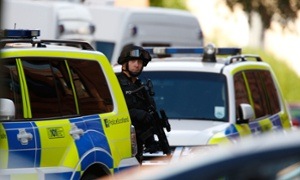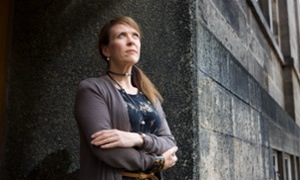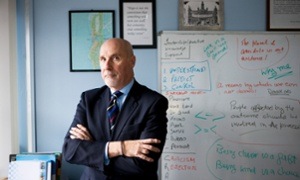In a squat redbrick community hall in the shadow of a pair of vertiginous north Glasgow tower blocks, half a dozen men sit on plastic chairs around a sturdy wooden table. The carpet is threadbare, the overhead lights harsh. Through shatterproof glass windows, dusk has turned to night.
“I can’t get a job anywhere, not with my history,” a lean man in late middle age says, his eyes turned downward. A little further along the table, a lad in his early 20s with a tattoo on his neck emphatically nods: “I need to get my shit together.”
There are echoes of the 12-step programme in the raw honesty, the white knuckles and supportive arms on shoulders. But this monthly meeting is being organised by a Scottish police taskforce, the Violence Reduction Unit (VRU). The man with his head bowed has a conviction for murder. Opposite him is a onetime major drug dealer. Another has done time for assault. Everyone around the table is on the same, long road: trying, with help from the VRU, to wrest new lives from the ashes of old, chaotic, violent ones.
The Violence Reduction Unit is a product of Glasgow’s own turbulent recent past. The unit, initially part of Strathclyde police, was set up in 2005 to tackle the city’s endemic knife fighting and gang crime. At the time, Glasgow was western Europe’s murder capital. A decade later, Glasgow’s murder rate has more than halved, from 39 in 2004-05 to 18 last year. Similar drops have been recorded for attempted murder, serious assault and possession of an offensive weapon.
The precipitous decline began when police acknowledged that the only way to stem the tide of violence was to tackle the culture that spawned it, says John Carnochan, a former Glasgow murder detective involved in setting up the VRU. While young men grew up in unstable, violent homes, joined gangs, carried knives, drank and fought, death and mayhem was almost inevitable.
The VRU attempted to break this cycle. Their strategy – borrowed from anti-gang violence initiatives spearheaded in Boston in the 1990s – combined creative thinking with old-fashioned enforcement.
Doctors, nurses, dentists, even vets were all enlisted to look out for the signs of violence and domestic abuse, and to counsel the young men who arrived at every hour of the day with fresh knife wounds.
There were legislative changes, too. The VRU lobbied successfully for increases in maximum sentences for carrying knives. Where previously those caught with a blade were allowed back on their street while their case slowly progressed through the justice system, now once caught they were fingerprinted, DNA-swabbed and held in custody until court.
Paul joined the VRU’s small team last year. The 37-year-old father of three has a calm, quiet self-possession that belies the chaotic story of his life. Born to an alcoholic mother and abusive father, he grew up in a North Glasgow house “where no one ever showed any emotion”. When his grandfather dropped dead in front of him, nobody asked how he felt.
Within a few years he was running away from home. By his early teenager years, he was in a gang, talking drugs and getting into fights.
One night, a street fight went badly wrong. Paul (not his real name) was quarrelling with a childhood friend at a bus stop. His erstwhile pal fell under the wheels of a bus. He was crushed to death. Paul pled guilty to culpable homicide and was sent to prison.

Released back into the same environment he had left, filled with drink, drugs and violence, Paul decided he had to change. “I’d been in prison and I’d been in care and I didn’t want my kids going through what I went through,” he recalls.
Then he met the VRU. In 2008, the unit – extended the previous year to cover all of Scotland – had set up the Community Initiative to Reduce Violence (CIRV) in Glasgow’s East End, where sprawling housing schemes had hosted the worst of the gang violence. More than 600 gang members were “called in” to listen to hard truths from police, paramedics, the mother of a young man killed by a gang with machetes, and former offenders, including Paul.
“I felt excluded all my life,” he says. “Now here was the police, who used to exclude me all the time, and they were trying to include me.”
Funded primarily by the Scottish government, CIRV combined the carrot and the stick. Gang members were given a choice: renounce violence and get help into education, training and employment, or face zero tolerance on the street.
The results were remarkable. Among the 200 gang members who became directly involved with CIRV, violent offending fell by almost half, according to a 2011 study. Weapon possession was down 85%. Even among gang members who had not attended a call-in, violence had fallen by almost a quarter.

The walls of Karyn McCluskey’s cluttered office, located in a 1970s office block in downtown Glasgow, are decorated with photographs. There is a picture from a stint at the Met in London in 2010 – her long, sandy-coloured hair and knee-length boots stand out among a sea of men in uniforms – alongside stark, black-and-white photos of blood-soaked young Glaswegians in doctors’ surgeries.
“People ask me, ‘Why do you spend your time getting these bad boys jobs?’ I always say, ‘I’m not doing it for them, I’m doing it for their kids,’” McCluskey says.
In 2004, McCluskey was a young intelligence officer on Strathclyde Police. Then commissioner Sir William Rae asked the recent recruit from West Mercia to pen a report on how to reduce the city’s headline grabbing rates of violence. McCluskey’s paper lead directly to the creation of the VRU. A decade later, she is the unit’s director.
A long-time single parent, McCluskey has no shortage of empathy for the young men – they are overwhelmingly men – whose names and faces come across her desk. She goes to the christenings of ex-offenders’ children; more than once, our long conversation is broken by a phone call from a charge seeking advice. But she is hard-headed, too, which perhaps explains why home secretary Theresa May is one of her many fans.
McCluskey believes inequality breeds violence. She wants “a revolution” in how we tackle violence – by focusing on the traumatic environments in which so many offenders are reared. Reversing the effects of 20 years of deprivation and neglect is not easy, but it has to be done.
“If jail on its own worked, America would have no crime,” she points out. “You need a different approach.”
Part of this fresh tack is enlisting former offenders and gang members to work continually with current ones trying to escape the chaos. One of those former members is Paul, who, having participated in the CIRV project, was recruited by the VRU as a “navigator”. The best part of his job, he says, is when his charges realise that they, too, can change. “You can see the light going on. They have an opportunity to break a cycle that has gone on for years.”
One of the young men Paul works with is 19. His earliest memory is his father holding a gun to his mother’s head: she was using her son as a shield. “Once you understand where he is coming from, it is not hard to want to help him,” Paul says.
Although Glasgow’s crime rates have continued to fall, some question the
VRU approach. “Violence dropped and weapon-carrying
offences dropped, but that was on the back of substantial work by
police and other agencies,” says William Graham, a lecturer in criminology at Abertay University. “So it is hard to say that CIRV was the sole cause of the reductions, though it did show a degree of success.” Some say the publicity-savvy VRU were given credit for a general decline in violence across Scottish society.
But former murder detective and VRU founder John Carnochan warns that people “might forget how bad it was” in Glasgow. “All we have done to that community is to show what life is like without gang violence. We have changed the normal. Same as we changed the normal for smoking. But the challenge is keeping the normal.”
Now retired, Carnochan spends much of his time travelling the world talking about the VRU. “All we did was start to think about things differently,” he says. “It was really difficult but it was wonderful, too.”

CIRV was discontinued in 2011. Although the programme seemed to produce significant falls in violent crime, a source close to the project says the political will wasn’t there to carry on funding it once government funding ran out.
Across Scotland, the policing climate has changed dramatically in recent years. Previously separate forces such as Strathclyde are now amalgamated. The new national force, Police Scotland, has often been accused of adopting a command-and-control approach, focused more on cracking down on crime than addressing its causes. Stop and search has been used excessively, with young men in deprived communities disproportionately targeted.
The VRU approach of “caring people into change”, as one officer puts it, doesn’t necessarily fit well with such heavy-handed tactics. Now the VRU is looking for new ways to ensure ex-offenders stay out of the cycle of drink, violence and, often, early death. They established a small charity to create employment opportunities for former gang members who might otherwise struggle to find jobs, modelled on Homeboy Industries in Los Angeles. Early projects included work placements at the Edinburgh Tattoo and last year’s Commonwealth Games in Glasgow. So far, 79% of those involved are still in employment. The eventual goal is to set up a social enterprise restaurant in the city centre.
Back in north Glasgow, the evening’s meet-up is drawing to a close. The last person to speak is the quietest. Michael, not his real name, spent time in prison for assault. Tonight he is exhausted, but not from the all-day benders he used to go on. He was up at 5am for work in a burger van near a building site. His first child was born before Christmas.
“I want to show my wean something I never had.” His voice is low, but the note of pride is unmistakable. When he finishes everyone around the table is smiling.
This piece originally appeared in the print Guardian April 6, 2015.